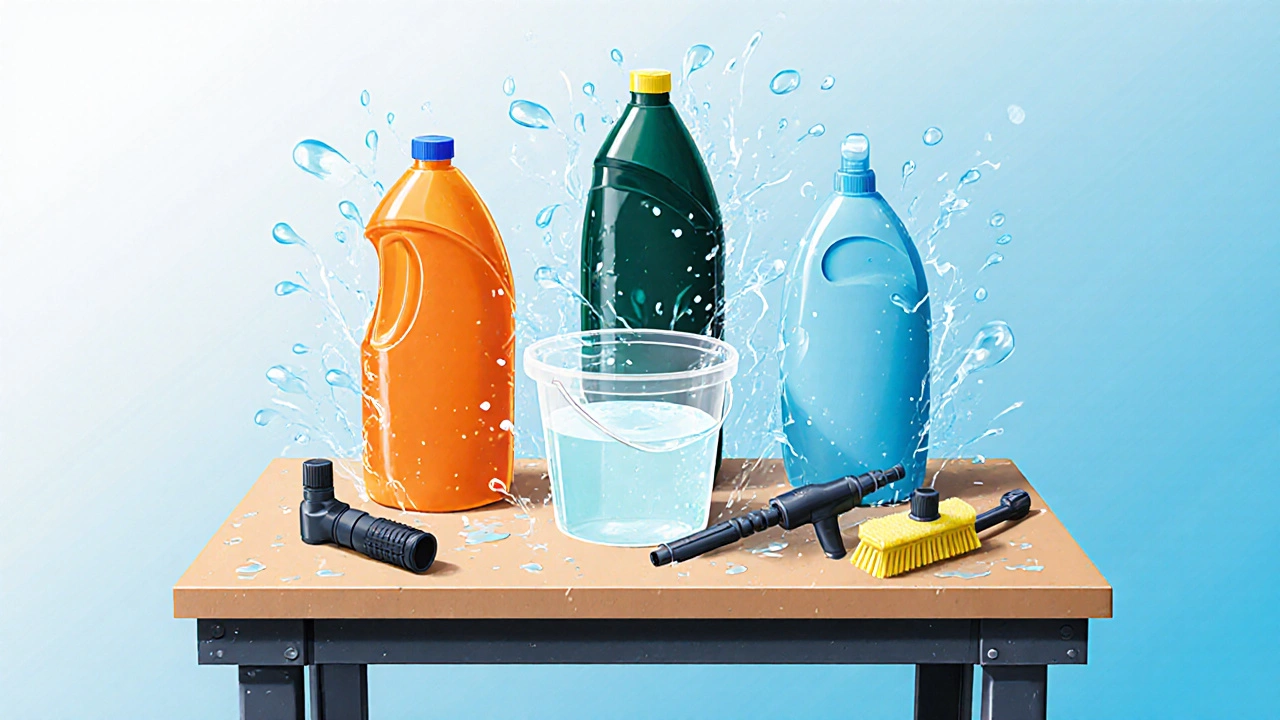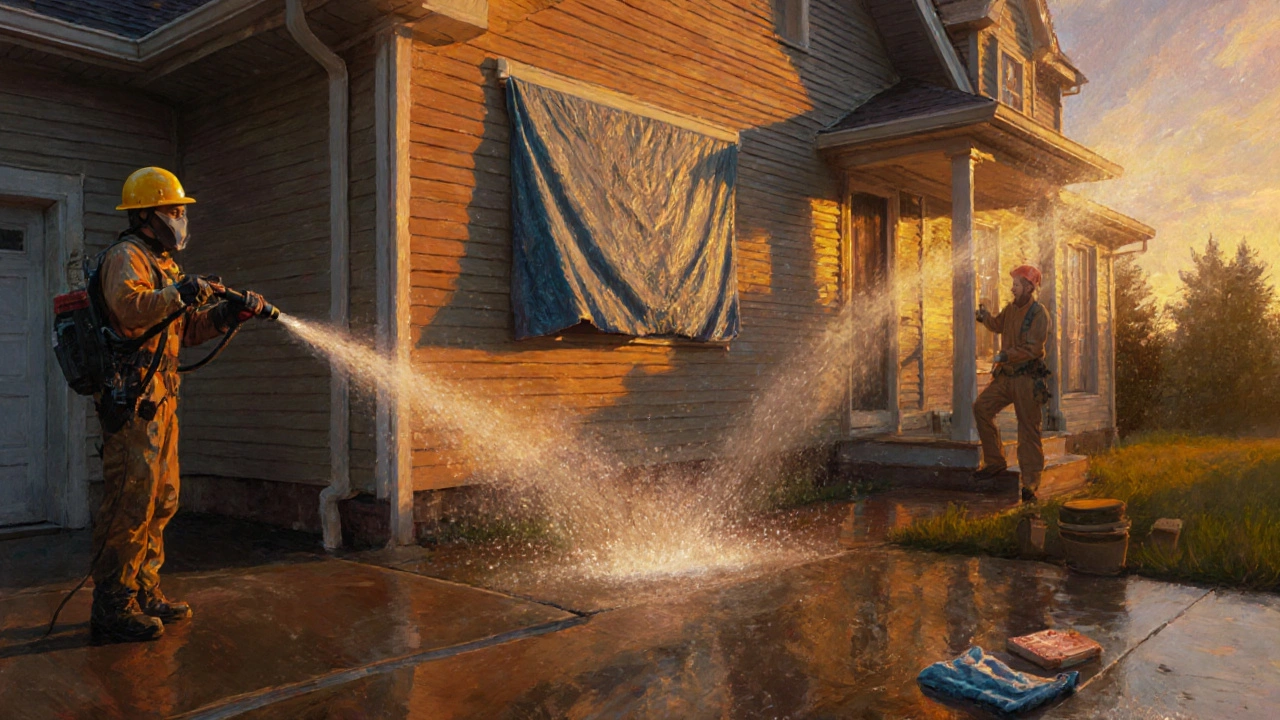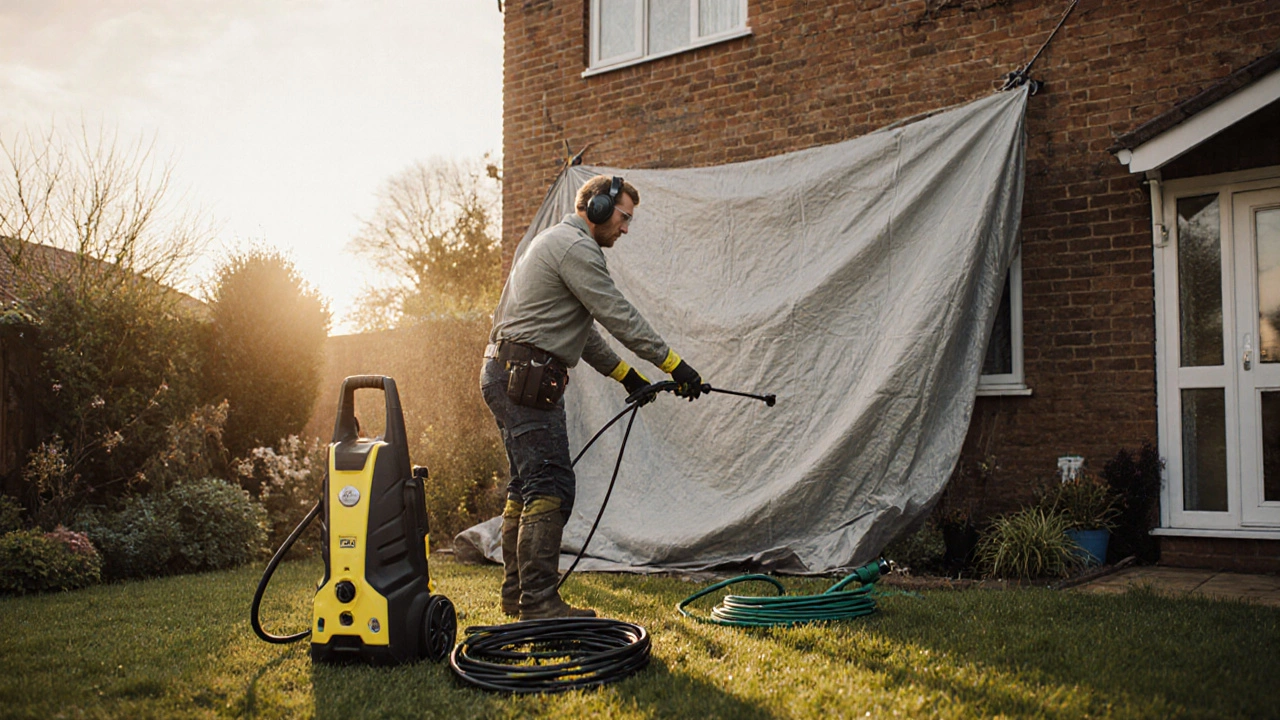Pressure Washing Detergent Calculator
Find the perfect detergent dilution ratio for your pressure washing project. Enter your surface type and stain type to get the recommended concentration.
Pressure Washing is a high‑pressure water cleaning method that blasts away grime, mold, and oil from exterior surfaces. Before you fire up the machine, a solid prep plan saves time, protects delicate areas, and ensures a spotless finish. Skipping the prep can lead to ruined paint, water damage, or clogged nozzles, so let’s walk through everything you should have on hand and why it matters.
Why proper prep matters
Even the most powerful washer can’t fix mistakes made before you start. Unprotected plants may get scorched, loose siding can be ripped off, and stubborn stains often need pretreatment. A good prep routine reduces runoff, protects nearby landscaping, and extends the life of your equipment.
Safety gear you must have
High‑pressure water can cause serious injuries if you’re not geared up. Keep these items within arm’s reach:
- Safety Goggles protect your eyes from flying debris and splashing water
- Gloves water‑resistant, grip‑enhancing gloves prevent slips and hand irritation
- Sturdy, non‑slip boots
- Long‑sleeve work shirt
- Ear protection if you’re using a loud electric pump
Protecting delicate surfaces
Before you start spraying, cover anything that can’t handle high pressure:
- Protective Cover heavy‑duty canvas or tarps shield windows, plants, and outdoor furniture
- Plastic sheeting for outdoor lighting fixtures
- Masking tape on freshly painted trim to avoid paint stripping
Secure covers with rope or bungee cords so they don’t flap in the wind and get caught by the spray.

Choosing the right cleaning agents
The right detergent makes the difference between a quick rinse and a stubborn stain that needs extra scrubbing later. Here are three common categories:
| Cleaner Type | Best For | Typical Concentration | Eco Rating |
|---|---|---|---|
| All‑Purpose Detergent | General dirt, dust, pollen | 1:10 diluted | Medium |
| Concrete Degreaser | Oil stains on driveways, garage floors | 1:5 diluted | Low (contains solvents) |
| Eco‑Friendly Cleaner | Mold, algae, sensitive surfaces | 1:15 diluted | High (biodegradable) |
For most home exteriors, an Detergent that’s pH‑balanced and biodegradable works well. Apply it with a low‑pressure sprayer, let it sit 5‑10 minutes, then rinse.
Tools and equipment checklist
Beyond the washer itself, gather these essentials:
- Garden Hose for rinsing and providing a water source to the pump
- Heavy‑duty extension cord (if using an electric unit)
- Extension Cord rated for 15 A or higher to avoid overloads
- Adjustable nozzle (0‑40°) for different spray patterns
- Plastic bucket for mixing cleaners
- Soft‑bristle brush for pre‑scrubbing stubborn spots
- Sealant or clear coat for post‑wash protection (optional)
Step‑by‑step pre‑wash routine
- Clear the work area: Move outdoor furniture, trim low‑lying plants, and sweep debris.
- Cover sensitive items with protective covers and tape off painted trim.
- Inspect surfaces for cracks or loose panels; repair them before washing.
- Connect the garden hose to the pressure washer’s water inlet and ensure a steady flow.
- Set up the detergent tank or add cleaner to the low‑pressure soap nozzle.
- Apply the cleaning solution with a gentle spray, working from top to bottom.
- Allow the solution to dwell (5‑10 min). For mold or algae, a longer dwell may be needed.
- Switch to a higher‑pressure nozzle (e.g., 0‑25°) and rinse thoroughly, again starting at the highest point.
- Check for missed spots; re‑apply cleaner if necessary and rinse.
- Remove all protective covers, dry delicate items, and consider applying a sealant on concrete or wood.

Common pitfalls and how to avoid them
- Over‑diluting detergent: Too much water reduces cleaning power; stick to manufacturer‑recommended ratios.
- Skipping pre‑scrubbing: Stubborn oil or paint chips need a brush before you spray.
- Using the wrong nozzle: A 0‑10° tip can gouge wood; keep a 20‑40° tip for most surfaces.
- Neglecting safety gear: High‑pressure streams can embed particles into skin.
- Ignoring water runoff rules: In many UK municipalities, runoff into storm drains is restricted; direct water to a garden soak‑away if possible.
Quick pre‑wash checklist
- Safety goggles, gloves, non‑slip boots
- Protective covers and masking tape
- Garden hose, extension cord, pressure washer
- Detergent (pH‑balanced), bucket, brush
- Sealant (optional) for post‑wash protection
- Clear area of furniture, toys, and plants
Frequently Asked Questions
Do I need to move my car before pressure washing the driveway?
Yes. Even a low‑pressure rinse can splash debris onto a vehicle’s paint. Move the car or cover it with a waterproof tarp to prevent streaks or scratches.
Can I use regular dish soap as a pressure‑wash detergent?
Dish soap can create excess suds that clog the pump. Stick to cleaners formulated for pressure washers; they foam less and rinse cleanly.
How far should I keep my house’s windows from the spray?
Keep the nozzle at least 24 inches away from glass. A wider spray angle reduces pressure on the pane and prevents cracking.
Is it safe to pressure wash my roof?
Only if the roof is made of concrete tiles or metal and you use a low‑pressure setting (≤ 1500 psi). Slate or asphalt shingles can be lifted or damaged.
What time of year is best for pressure washing in the UK?
Late spring to early autumn offers warm, dry weather, which helps detergents work and prevents re‑freezing on surfaces.
